Questions about growing quality food plots are nothing new for NDA’s phone lines and e-mail in-boxes. But over time, new themes emerge among the questions, and for the last couple of years, one new theme has dominated: growing low-impact food plots.
We are receiving more and more questions from hunters who want to grow food plots but wonder if chemical fertilizers and herbicides might have adverse effects on soil, plants, wildlife or people. They wonder if it’s safe to eat venison from deer that have consumed crops produced with herbicides, and whether they can grow food plots without them. They wonder if genetically modified crops (GMOs) are harmful to wildlife and perhaps to the people who eat wildlife. These and other, similar questions reflect honest concerns, and this article contains our advice to these hunters. Following are 10 ways to minimize the environmental impact of your food plots.
1. Test the Soil
Before you plant food plots, always have your soil tested by a professional lab. This allows you to apply precisely the amount of fertilizer needed to maximize production of your crop. When you guess, or when you use a “ballpark” recommendation, you can easily apply more fertilizer than necessary or apply specific nutrients that are not necessary. Excess nutrients in soil that are not used by crops may end up in wetlands or streams if soil erosion occurs. Of course, if you under-fertilize, the crop will not perform to its potential, and your money and time spent establishing food plots are less effective.
2. Prevent Erosion
Avoid creating or planting food plots on slopes. This allows rainfall to easily carry soil (and herbicides or excess soil nutrients) into streams. Even on level ground, leave vegetated buffer zones between tilled land and any ditches, gullies, slopes, roads or streams that border it. Also, don’t plant food plots in areas that commonly flood. And, to help hold soil in place, minimize tillage as much as you can (see No. 4).
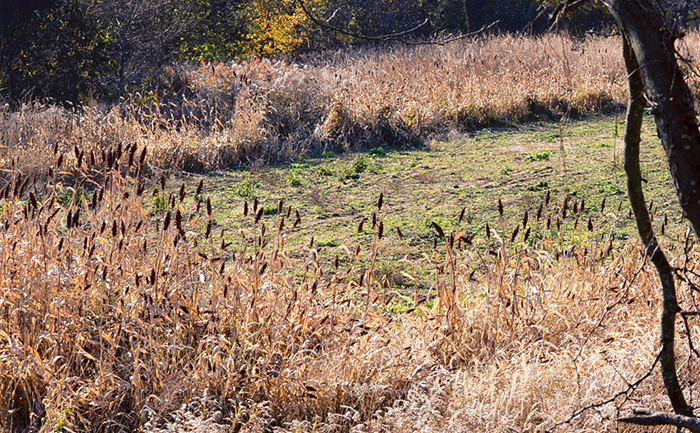
Buffers of vegetation around a food plot help prevent nutrients and soil from eroding into streams. They also help deer feel more secure using the plot in daylight.
3. Add or Build Organic Matter
As explained in NDA’s book, Quality Food Plots, the primary natural source of mineral nutrients in soil — including the “big three” (nitrogen, phosphorus and potassium, or N, P and K) — is decomposing organic matter. Often there is not enough decomposing organic matter to meet the needs of growing crops, and thus chemical fertilizers are used to fill the gap. You can reduce or maybe even eliminate the need for added fertilizers by increasing organic matter in the soil.
To begin with, avoid choosing food plot sites where native top-soil has already been removed, eroded or compacted in favor of sites with deep, healthy, well-drained top-soils. If it’s a good place to dig for fish bait, it’s got healthy soil. Earthworms are an indicator of high organic matter levels. This online guide can help you locate the best soil types where you hunt.
To increase organic matter, leave crop residues on or near the surface; do not turn them under with deep tillage. You can also bring in supplemental organic matter like compost or mulch.
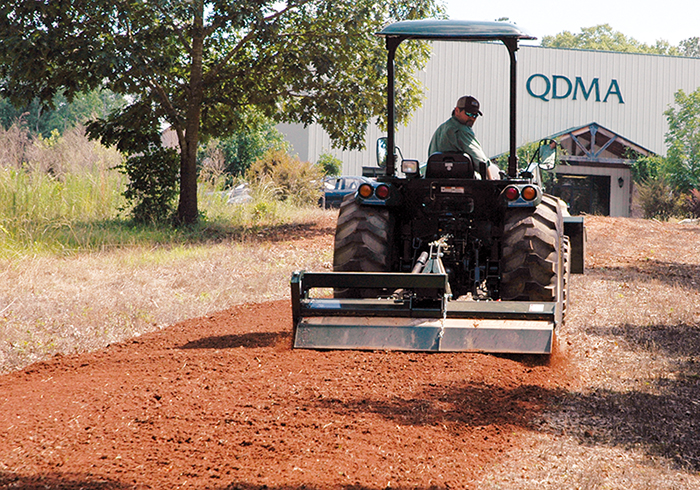
When tillage is necessary, shallow penetration with a rotovator like this one helps keep soil organic matter near the surface where it can do the most good.
Composted poultry litter, if available locally, is an organic option that increases nutrient levels, but remember that these nutrients are potentially just as harmful to streams and wetlands as chemical fertilizers if they leach or are eroded into groundwater. Livestock manure can increase organic material, but this is less desirable because it also contains weed seeds.
Another option is to plant so-called “green manure” crops on a rotation to build soil nutrients. For example, buckwheat, a warm-season annual, is a strong soil builder, and its residues release significant amounts of phosphorus after the plants die. Legumes that fix their own nitrogen, like soybeans and cowpeas, release that nitrogen into the soil when the plants die. Following crops like these with other crops that especially need those nutrients can reduce the need for added fertilizer. In fact, it’s important to maintain an unbroken rotation of seasonal crops (known as cover crops). Nutrients being released by organic matter can leach into groundwater in greater amounts if no crop is drawing on those nutrients, like when a field lies fallow for an entire season between plantings. So, follow warm-season crops with cool-season crops, and vice versa.
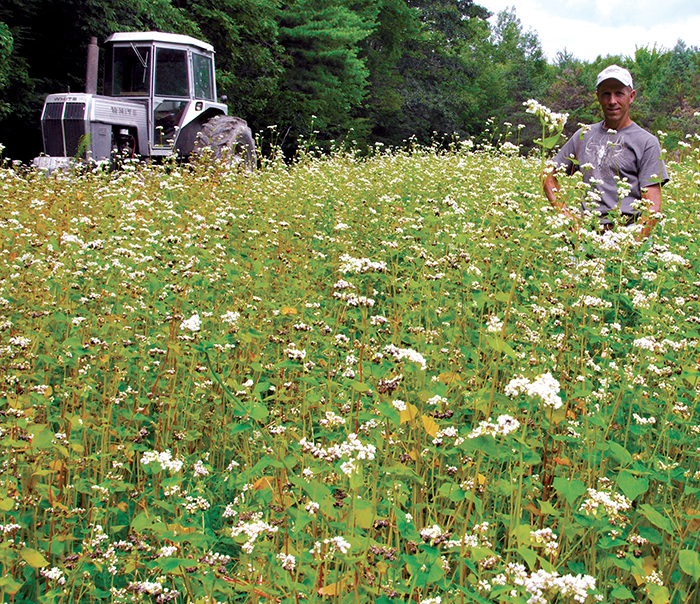
NDA member Roger Kingsley of Pennsylvania stands in a patch of buckwheat, a warm-season annual that is an excellent “green manure” that helps increase soil organic matter and phosphorus.
Depending on where you are working and the soil quality you are working with, you can use these techniques and produce decent food plots without fertilizer. The crops may not perform to their full potential that could be realized with supplemental fertilizers – especially with regard to the quantity of forage produced – but these food plots will still produce additional high-quality forage for deer.
4. Use Wise Tillage Practices
Whenever possible, plant seed with a no-till drill or use no-till broadcast methods like frost-seeding so you can skip seedbed preparation with disk harrows or rotary tillers. Some tillage may be necessary to help with weed control. However, tillage increases the potential for soil erosion, can stimulate weed growth that must then be controlled somehow, reduces soil moisture in dry periods, can contribute to soil compaction, and of course requires extra fuel consumption. So, till wisely and minimally.
Remember that building soil fertility works naturally from the top down: Crop residues left on the surface break down and filter down gradually into soil layers. Meanwhile, this residue conserves soil moisture. When you till, you disrupt the natural soil-building process.
Personally, I prefer to mow existing vegetation in a plot, spray with glyphosate to kill remaining weeds, and plant directly into the dead crop stubble and mulch, either with a no-till grain drill or simply by broadcasting seeds directly onto the surface. At the former NDA Headquarters, we had a lot of success simply broadcasting on top of the mower mulch. With larger seeds like soybeans or wheat, after broadcasting we pull a cultipacker with an ATV through the plot to “settle” the seeds into the mower mulch so they contact the soil (see the photo below). Small seeds like clover, chicory and brassicas may not need this step. If you can time all this with a good rain, you’re in business.
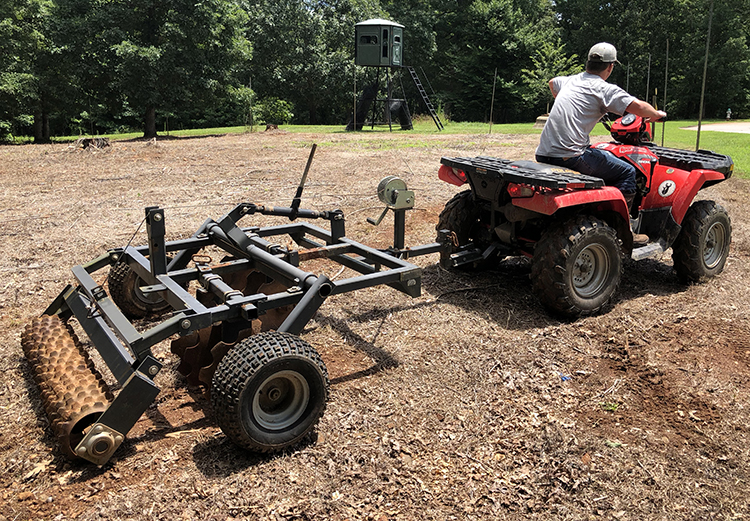
After mowing and spraying this plot in Georgia, we broadcast seed on top of the mulch layer, then used a cultipacker and very light disks to settle the seed. A forecasted rain fell that afternoon, and the result is seen in the photo at the top. No tillage was needed to produce this plot.
5. Use Non-Chemical Weed Control Methods
If possible, choose food plot locations in areas without a history of commercial agriculture because that usually means weed seeds are already present in the soil seedbank. You will still have weeds, but you may be able to keep many of them under control by hand-pulling or mowing, especially if you can remove the weeds before they go to seed. Perennial or biennial weeds like thistle, horsenettle and mullein can be controlled over time if you kill individual plants before they can spread their seeds.
If weeds are scattered, use spot-spraying with a backpack sprayer, which uses less herbicide than applying to the entire field. If warm-season weeds are a problem at a given location, grow only cool-season crops at that site until you control the weeds, and vice versa. Finally, consider mechanical weed control, like disking and row cultivation. You can keep most weeds under control in row crops like soybeans and corn by using a row-crop cultivator.
Using all of these approaches, you still may not be able to control all the weeds, but the deer don’t care. As long as weeds aren’t dominating and smothering the majority of your intended crop, deer will still gain benefits from your plot. Remember that many “weed” species that food plotters worry about are actually high-quality, preferred forage. Ragweed, wild lettuce, pokeweed and beggar’s lice are just a few good examples of “weeds” you shouldn’t waste time eradicating, because deer like to eat them. Learning to identify weed species will be helpful in your effort to minimize or eliminate herbicide use.
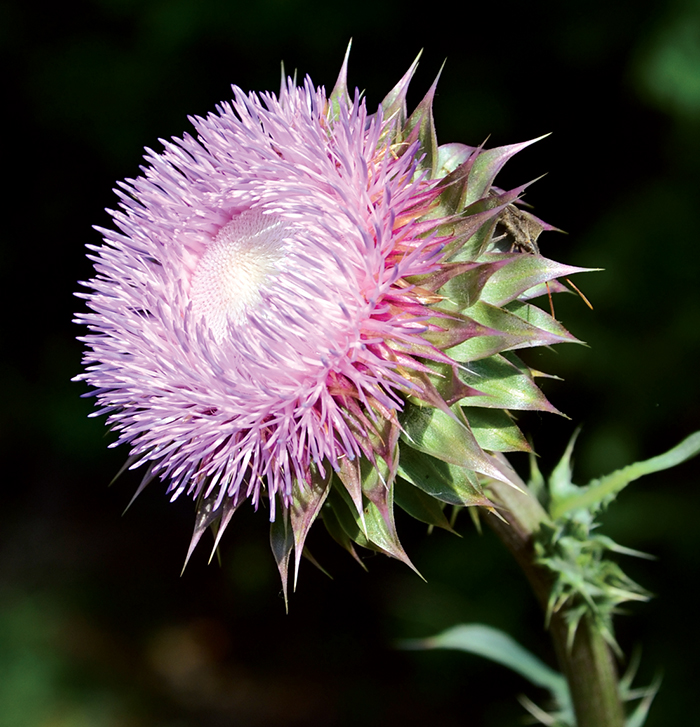
Weeds like thistle can be controlled over time if you kill individual plants before they flower and produce seeds. You can kill the plant by hand or spot-spray with herbicide.
6. Grow More Annuals
“Growing perennial forages without herbicides is very difficult,” said Dr. Craig Harper of the University of Tennessee, one of the primary contributors to Quality Food Plots.
Perennial clovers, chicory and alfalfa will suffer ongoing attacks from both cool- and warm-season weed species throughout the life of the stand, which can be three to four years or more given good fertility and weed control. To keep your weed headaches to a minimum and prevent or reduce herbicide use, focus on annuals. Warm-season annuals include soybeans, cowpeas, lablab, grain sorghum, buckwheat and others. Cool-season annuals include the cereal grains (rye, wheat, oats, triticale, barley), brassicas (rape, kale, turnips), crimson clover, and Frosty berseem clover. Quick-germinating, quick-growing annuals compete better against weeds, and they produce lots of biomass that can serve as mulch for increasing organic matter for the next crop.
7. Use Herbicides by the Label
The label instructions on a jug of herbicide are more than recommendations. They are federal law. It is illegal to use labelled herbicides in a way that exceeds the guidelines, such as applying too much herbicide per acre, making too many separate applications to the same crop in a certain period of time, or applying in a location or manner that is potentially harmful. That’s because the label guidelines are based on research and set by the EPA to prevent harm to people, plants, soil, water or wildlife.
Based on the preponderance of scientific research and evidence, NDA is unaware of demonstrated harm to wildlife, water or people caused by any herbicide that we suggest for use on food plots when used according to the label. This includes glyphosate. As we have pointed out, misuse or over-use of glyphosate can have negative consequences, like weed resistance. This year, the EPA released a new draft assessment of human health and ecological risks for glyphosate, with recommended risk management options, if any, to follow soon.
Completely eliminating the use of herbicides on food plots is a laudable goal, but it may be tough to accomplish. Minimizing their use is a more realistic goal (like spot-spraying instead of applying to an entire field when it’s not necessary). But whatever you do, when you use herbicides, always use them according to the label!

When using herbicides, follow label instructions to the letter, as the label guidelines are based on scientific research and intended to prevent harm to people, wildlife, soil or water.
8. Ask About Neo-Nicotinoids
Neo-nicotinoids (or neonics) are EPA-approved insecticides that are applied to nearly all commercial corn crops and almost half of all soybeans planted in the United States. Because of new concerns about potential links between neonics and honeybee colony collapse disorder (CCD), the EPA has reopened testing of these insecticides and hopes to conclude their review in 2019. Currently, the majority of corn and soybean seed on the U.S. market has been pre-treated with neonics, which enter the growing plants and provide protection against damaging insects for a certain period of growth.
NDA will await results from additional testing and follow any new recommendations or regulations from the EPA regarding these products. In the meantime, if you wish to avoid using seed pre-treated with neonics, ask your seed supplier if their seed is treated and whether untreated seed is available.
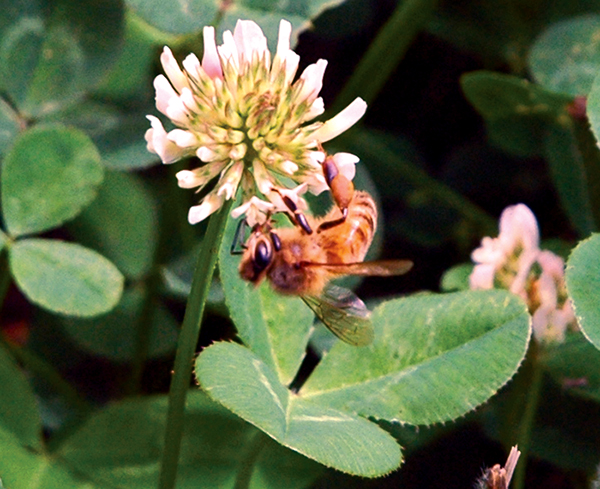
The EPA is currently studying neo-nicotinoid herbicides out of concern for a potential link to colony collapse disorder in bees.
9. Learn More About GMOs
GMOs, or genetically modified organisms, are scientifically improved crops like “Roundup Ready” corn and soybeans, which are genetically engineered to resist the effects of glyphosate. While there is much public debate and ongoing research, NDA is not aware of reliable, peer-reviewed scientific evidence that GMO crops present potential harm to wildlife or people. To learn more, we recommend the website GMO Answers, contributors to which include independent experts from universities, health organizations, and other groups. We will continue to follow research and modify our recommendations as needed, but in the meantime, if you have concerns, you can always choose non-GMO crops for your food plots.
10. Don’t Grow Food Plots
If the rest of this article doesn’t address your own concerns, and you want to completely avoid chemical fertilizers, herbicides, GMOs, mechanical tillage or other techniques, then remember that it’s entirely possible to manage deer and produce high-quality habitat without any food plots. Creating more early successional cover by putting sunlight on the ground will create more forage and browse for whitetails. A number of Timber Stand Improvement techniques can be employed to reach this goal, and open areas can be managed to create “Old Field” cover and forage. Prescribed fire, a natural and beneficial tool when used correctly, can help keep these areas in early stages of plant growth. In fact, areas with abundant natural forage can produce deer food for less cost per acre than food plots, and across more months and seasons (watch the video below). In the end, food plots are just one option in the habitat manager’s toolbox.
At NDA, we see it as a good thing that we continue to get more questions about proper stewardship of land, water, wildlife and – by connection – human health. In every segment of society, interest in low-impact living is growing. In fact, many people who have never been hunting before are now being attracted to hunting because they see the appeal of procuring their own meat, especially meat that is local, organic, wild, and free of unnatural ingredients.
The venison in my freezer is much more natural than products from the grocery store that we all consume every day, even if that deer happened to feed in a food plot that was produced through appropriate use of fertilizers and herbicides. Nevertheless, I still want to do the best I can for deer, for my family, and for all wildlife. I’m sure you do too.
